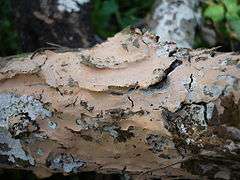Corticiales
The Corticiales are an order of fungi in the class Agaricomycetes. The order is mostly composed of corticioid fungi, but also includes one anomalous agaricoid species, Marchandiomphalina foliacea. Species within the order are generally saprotrophic, most of them wood-rotters, but several are parasitic on grasses or lichens. Those of economic importance include Waitea circinata, a pathogen of cereal crops, and Laetisaria fuciformis, the cause of red thread disease in turf grass.
| Corticiales | |
|---|---|
 | |
| Erythricium laetum | |
| Scientific classification | |
| Kingdom: | Fungi |
| Division: | Basidiomycota |
| Class: | Agaricomycetes |
| Order: | Corticiales K.-H. Larsson (2007) |
| Families | |
| Synonyms[1] | |
|
1907 Protohymeniales Lotsy | |
Taxonomy
The order was established in 2007 by Swedish mycologist Karl-Henrik Larsson, based on molecular phylogenetic research.[2] Though the precise boundaries of the order and its constituent families are yet to be resolved, it includes the Corticiaceae (the type family) as well as the Punctulariaceae and Vuilleminiaceae.[3]
Habitat and distribution
The order is cosmopolitan and contains around 150 species of fungi worldwide.[4] The majority of species in the Corticiales are saprotrophs, most of them wood-rotters, typically found on dead attached branches. Species of Laetisaria, Limonomyces, and Waitea are facultative or obligate parasites of grasses; species of Marchandiobasidium and Marchandiomyces are parasites of lichens; Marchandiomphalina foliacea is itself lichenized.[5]
Economic importance
Waitea circinata is an important pathogen of commercial cereal crops, causing a number of diseases including sheath spot of rice.[6] The same fungus also causes brown ring patch in turf grasses.[7] Laetisaria fuciformis is the cause of red thread disease in turf grass.[8]
References
- "Corticiales K.H. Larss. 2007". MycoBank. International Mycological Association. Retrieved 2010-12-03.
- Hibbett DS; et al. (2007). "A higher level phylogenetic classification of the Fungi". Mycological Research. 111 (5): 509–547. CiteSeerX 10.1.1.626.9582. doi:10.1016/j.mycres.2007.03.004. PMID 17572334.
- Ghobad-Nejhad M, Nilsson RH, Hallenberg, Hallenberg, N. (2010). "Phylogeny and taxonomy of the genus Vuilleminia (Basidiomycota) based on molecular and morphological evidence, with new insights into Corticiales". Taxon. 59 (5): 1519–1534. doi:10.1002/tax.595016.CS1 maint: multiple names: authors list (link)
- Kirk PM, Cannon PF, Minter DW, Stalpers JA (2008). Dictionary of the Fungi (10th ed.). Wallingford, UK: CABI. pp. 12–13. ISBN 978-0-85199-826-8.
- Lawrey JD, Diederich P, Sikaroodi M, Gillevet PM (2010). "Remarkable nutritional diversity of basidiomycetes in the Corticiales". American Journal of Botany. 95 (7): 816–823. doi:10.3732/ajb.0800078. PMID 21632407.
- Lanoiselet VM, Cother EJ, Ash GJ (2007). "Aggregate sheath spot and sheath spot of rice". Crop Protection. 26 (6): 799–808. doi:10.1016/j.cropro.2006.06.016.
- Toda T, Mushika T, Hayakawa T, Tanaka A, Tani T, Hayakumachi M (2005). "Brown Ring Patch: A new disease on bentgrass caused by Waitea circinata var. circinata". Plant Disease. 89 (6): 536–542. doi:10.1094/PD-89-0536.
- "Red Thread lawn disease - cause, symptoms and treatment". Retrieved 2010-12-03.